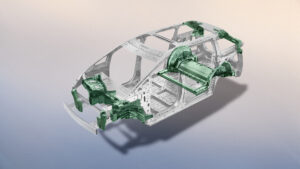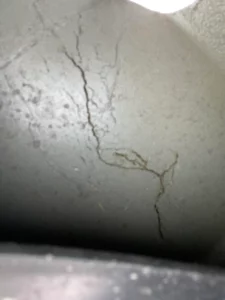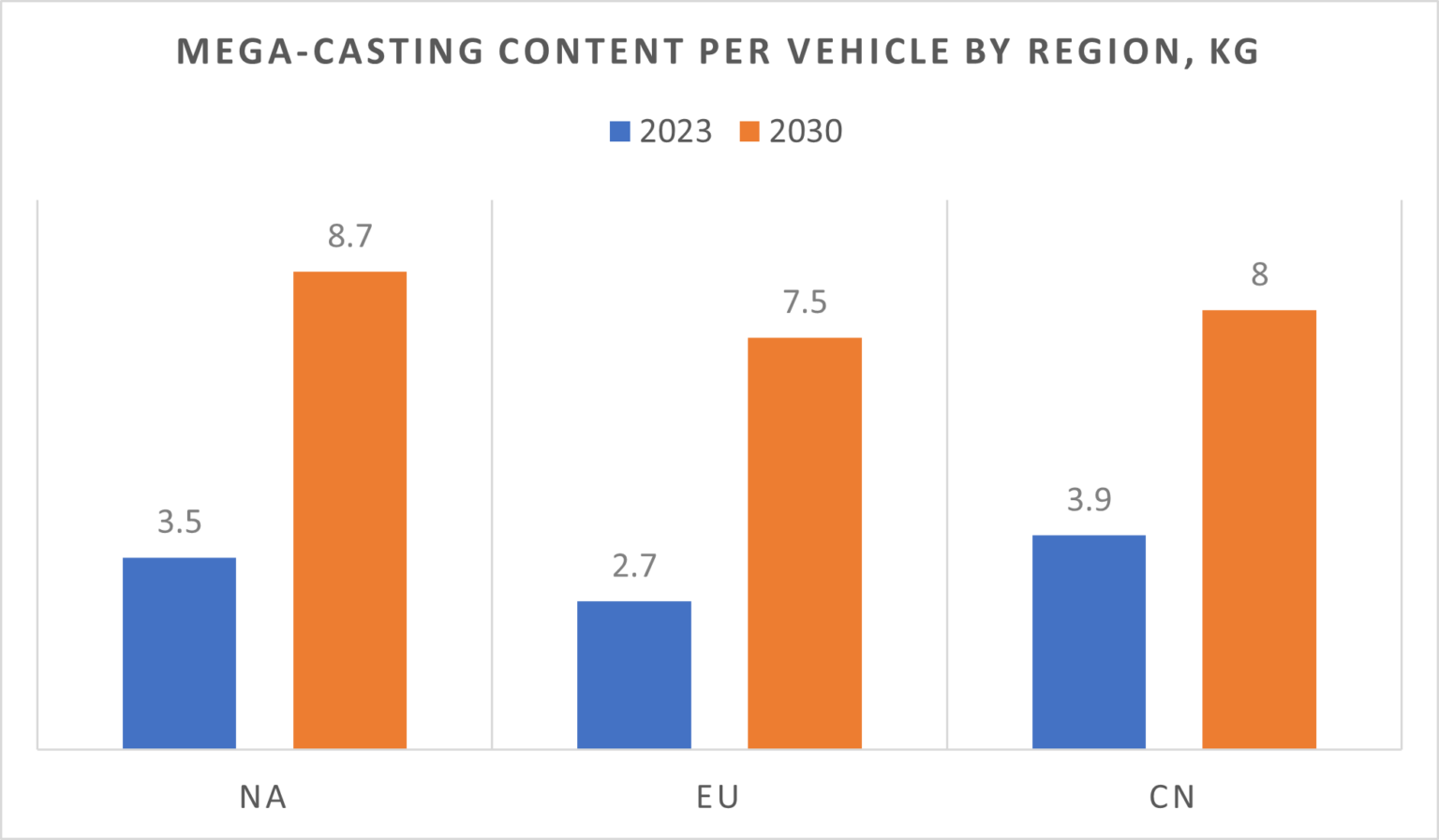
Megacasting long-term durability unknown, costly barriers to widespread use
By onMarket Trends
Ducker Carlisle has found the recent introduction of megacasting leaves unknowns regarding durability and the impact of aging and poses barriers to adoption by legacy OEMs.
Tesla is the forerunner in the use of megacastings, which are large aluminum castings, and dubbed them “gigacastings.”
Ducker Carlisle has tracked megacastings adoption since its inception. As of 2023, China leads the globe in producing vehicles with a megacasting at 700,000 vehicles, or 2.8% of total production, according to DuckerCarlisle. It’s forecasted to grow to more than 2 million by 2030, or 6.4% of total production.
North America is second with 400,000, or 2.4% of total production. Of the vehicles in the European Union, 260,000, or 1.8% of total production, have a megacasting.
“As the production cost of BEVs remains higher than ICE vehicles (mostly due to the battery costs), OEMs must find additional solutions to lower costs and vehicle MSRP, leading to a growing interest for megacastings,” DuckerCarlisle wrote in a recent article. “Several Chinese OEMs including HiPhi, NIO, Seres, Xpeng, and Zeekr have successfully followed Tesla’s steps with megacasting applications; most of the time outsourced to suppliers such as HongTu, Linamar, TuoPu, and WenCan (Le Bélier).
“Some OEMs like Li, XiaoMi, HongQi, and ChangAn explore the process and the possibility to develop in-house megacasting productions. Due to the level of investment, newcomers and new factories are preferred for megacasting implementation as they tend to bring fewer challenges related to the amortization of existing production lines, lowering the entry point for innovative manufacturing processes.”
Bertrand previously told Repairer Driven News that megacasting, new components, and new alloys that vehicles are made of change repairability and repair processes that make certain training and equipment critical for repair shops.
“It requires an extra level of cautiousness with regards to how all the materials are put together where previously when you had steel parts every part can be slightly different, which is less of the case with aluminum,” he said. “Therefore, you could work your adjustment between the parts when you rebuild the vehicle… it requires different training and different approaches on how to reassemble a vehicle that is that complex with mixed material approaches.”
A 2022 whitepaper from Ducker noted doubts about the repairability, life cycle, and aging of the castings.
Ducker’s newest research cites the cost of the technology as an additional barrier to use.
Creating them requires 4,400-6,000-ton presses and highly specialized mold designs, which have high annual maintenance and replacement costs. The scrap rate, difficulty in achieving perfect components the first time, and lack of heat treatment options are other issues OEMs face, Ducker said.
“Currently, OEMs are applying different solutions including ultrasonic inspections or X-rays to identify hidden defects,” Ducker wrote. “Improvements include the development of new alloys that don’t require heat treatment and mitigate the occurrence of porosity-related issues.
“There are other solutions being investigated to improve productivity, costs, and quality, including going with larger presses, some exceeding 12,000 tons, and up to 20,000 tons for the largest press announced to date. OEMs and suppliers are exploring additional innovations including new alloys and exploring Rheocasting (semi-molten alloy injection to improve penetration of material in the die) as a viable alternative.”
Post-production, Ducker found only one occurrence of cracks in megacasting. Nizar Kamel found last year just two months after getting his Tesla Model Y that it had a “sizable” crack in the front aluminum casting, according to Auto Evolution.
“At delivery, I inspected the car based on the main things other owners said to check,” he told Auto Evolution. “At the time, everything was fine, but I did not check the frame or structural members, as the car was new from the factory, and one shouldn’t have to check that.”
He reportedly denied his car had been in any collisions and found the damage when he was checking for a brake fluid cap that Tesla warned could be missing from some models. He then posted about it with photos and video on Twitter and Reddit.
“No other incident has been reported, and it will take years to define whether this will remain an isolated incident or if it’s the tip of the iceberg,” Ducker wrote in its article. “…replacement of a megacasting component [is] nearly impossible, while repairability would require redesigning these components and creating new subcomponents (castings and extrusions) with specific repair zones.
“Not everyone may adopt megacastings, but Tesla has shaken the automotive industry and opened the way to innovation in vehicle platforms and manufacturing.”
In November, S&P Global Mobility wrote about similar findings.
“These massive gigacastings (also known as megacastings) carry huge initial startup costs, may have distortion issues in the metal, alter collision-repair capabilities, and require extensive end-of-line inspection scanning. And that is only after ordering a custom-built gargantuan piece of equipment, moving it into place, and figuring out how to efficiently work the temperamental processes.”
S&P forecasts, based on market share of advanced steels, stampers of those components, and conversion rates in adoption scenarios, that 15-20% of traditional body-in-white (BIW) stampings in 2030 may be at risk from these gigacastings. S&P noted that underbody components typically comprise about 50% of a vehicle’s BIW shell, and the soft underbelly is the target of gigacasting’s focus.
“OEMs are looking towards gigacasting not as a component piece, but as a change to how their entire world functions,” S&P wrote. “The reconfiguration of the dance played behind factory walls will forever change economies within automotive. Whether corner castings or single piece, whether gigacast or gigapress, a change to how vehicles come together is upon the industry. Nodal construction will replace linear, bottlenecks will arise and dissolve, and something altogether new will be born.
“As Elon Musk has noted, it’s more complicated to make the ‘machine that makes the machine’ than the end product itself… S&P Global Mobility sees numerous obstacles ahead, including challenges related to the quantity of gigacasting machines, new issues arising in plant floor management, the need to explore alternative technical solutions, and more.”
Images
Featured image: Xpeng X9 front- and rear-integrated aluminum die-casting body structure (Credit: Xpeng)
Chart credit: Ducker Carlisle
Images of Tesla Y crack shared on Reddit and imgur
More information
EV makers say materials used common, repairs aren’t always more expensive

